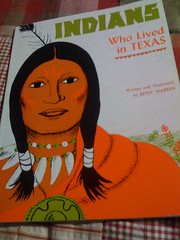 Written in Bone: Buried Lives of Jamestown and Colonial Maryland by Sally M. Walker. Carolrhoda Books, 2009.
Written in Bone: Buried Lives of Jamestown and Colonial Maryland by Sally M. Walker. Carolrhoda Books, 2009.
As this book migrated around the house it garnered varying reactions from the urchins and other family members:
Karate Kid (12): It’s O.K. I liked the bones.
Z-baby (8): Is that a skeleton? Is it a real skeleton from a real person?
Artiste Daughter (20): That’s what I want to be, a forensic anthropologist. Can I read it when you get through with it?
Engineer Husband: That’s a great book! Where did it come from?
I found it a little difficult to concentrate on the information in the book at first, but I soon became intrigued. This book is not dumbed-down or over-simplified for the younger set. In fact, like much YA fiction, this book would be perfectly appropriate for adult reading. Anyone who wants a layman’s introduction to a particular subject should get in the habit of checking out the children’s or young adult section of the library since the authors of nonfiction for young people are careful to explain things as completely as possible while keeping it easy enough for nonprofessionals to understand and appreciate.
In Written in Bone, Ms. Walker accompanies forensic anthropologist Douglas Owsley, a scientist at the Smithsonian Institution, at his invitation, as he and colleagues from several related disciplines study the remains of some of the Jamestown settlers and of other early colonials who lived in the Chesapeake region of Maryland. The stories of eight different inhabitants of early colonial America are told in nine chapters. The information about how archeology and anthropological studies are done is detailed, comprehensive, and interesting, and I understood most of it –a great accomplishment on the part of the author since my eyes usually glaze over at the mention of the word “science.” One technique that author uses to keep the pages turning is the end of the chapter (commercial break) teaser: “Inside the tent, Doug Owsley, Kari Bruwelheide, archeological conservators, and medical personnel analyzed and sampled the remains for further scientific analysis. What they found amazed and puzzled them.” I could just picture this book as a PBS special, a really good one.
 The chapter titles are sure to intrigue readers, too:
The chapter titles are sure to intrigue readers, too:
1. A Grave Mystery
2. Who Were You?
3. Out of the Grave
4. The Captain
5. The Body in the Basement
6. The Luxury of Lead
7. THe Lead-Coffin People
8. Expect the Unexpected
9. Remember Me
You want to read chapter five first, don’t you?
Ms. Walker does use some imagination and historical documentation to fill in the possible details of the lives of the people whose skeletons were excavated. Those lives include colonials that scientists believe were a teenage boy killed in Jamestown in a skirmish with the Indians, a ship’s captain, an indentured servant, a colonial official, his first wife, and his sickly baby, and an African slave girl. It’s amazing how much scientists can discover about these people and their daily lives as they use all sorts of new technologies to uncover the skeletons’ secrets. I’m really a history buff, not a science fan, but I loved the way the science made the history come alive.
Finally, I can’t leave this book without mentioning the beautiful full color photographs that accompany the text on nearly every page. The photos are large enough to see details, and the page layout isn’t too busy with too many little pictures but rather just enough photographic evidence to illuminate the written content. I wish I could reproduce one or two of the photos here, but you’ll just have to get a copy of the book and see for yourself.
How’s that for a nonfiction teaser?
 These are the closest examples I could get of Day-Glo (fluorescent) colors:
These are the closest examples I could get of Day-Glo (fluorescent) colors:

